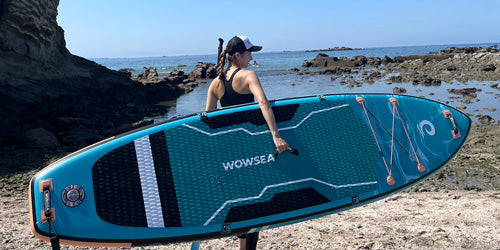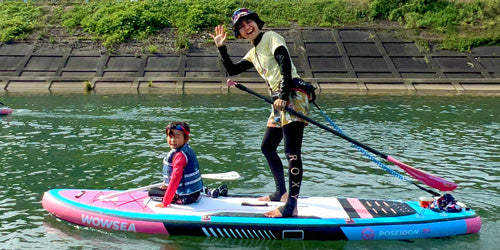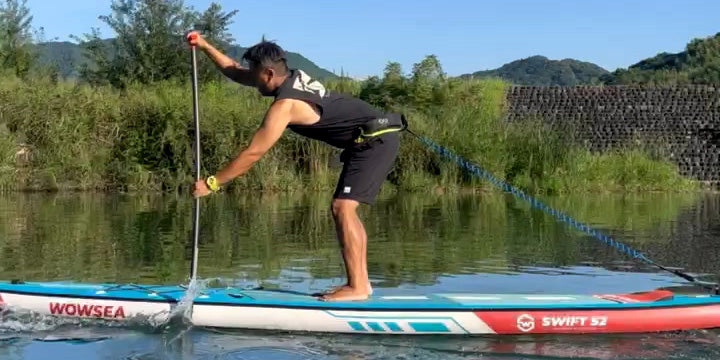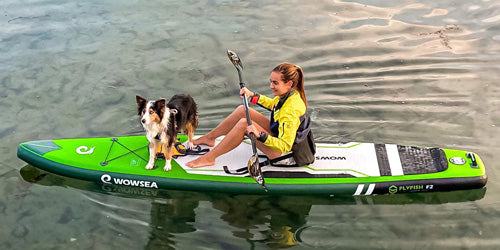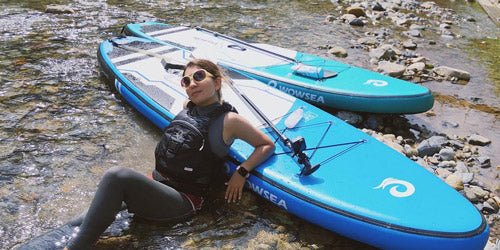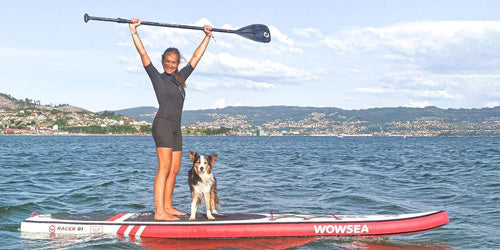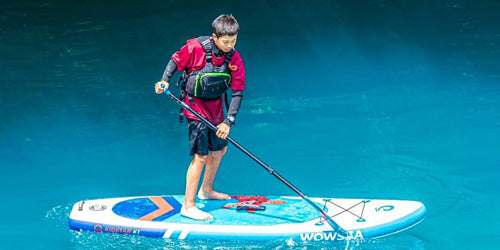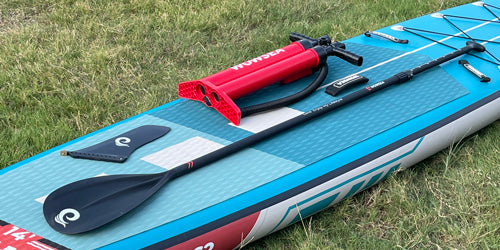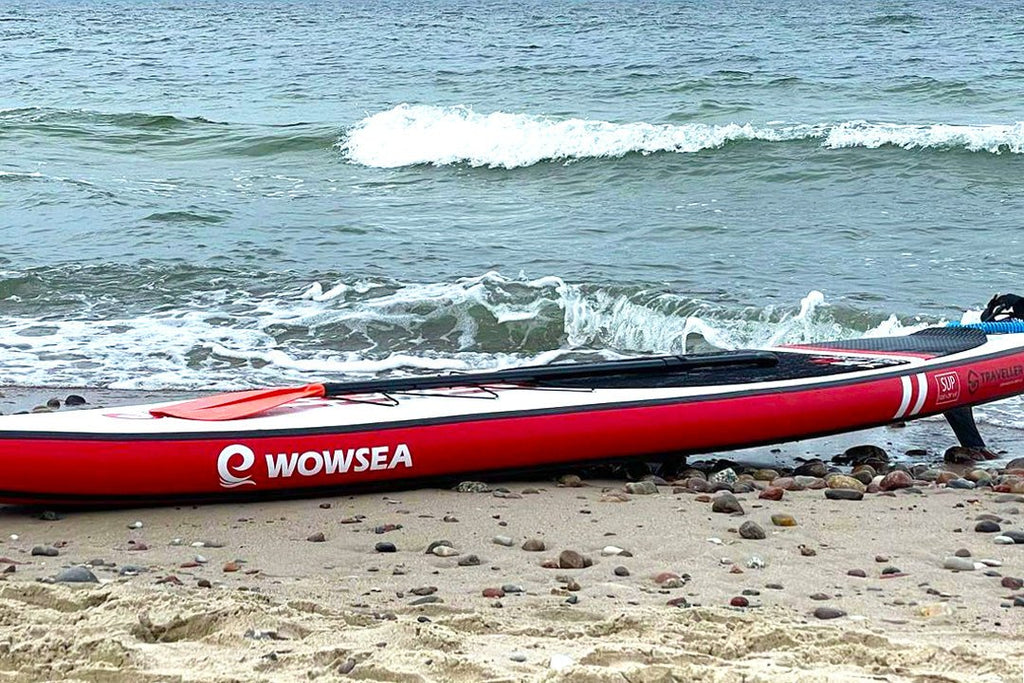How to Paddleboard in Strong Wind and Waves - Tips and Tricks
Stand-up paddleboarding (SUP) is a fun and relaxing way to explore the water. But it can also be challenging when faced with strong winds and waves. Before starting, knowing how to navigate these conditions is important. In this article, we'll share tips and tricks and how to paddleboard in strong wind and waves.
Prepare Yourself And Your Gear To Ensure Your Safety On The Water.
Before heading out into strong winds and waves, it's essential to prepare yourself and your gear to ensure your safety on the water. Here are some tips to follow:
Check the weather forecast:
Before heading out, check the weather forecast to ensure you're not caught off guard by any unexpected changes in wind or waves. If the forecast calls for strong winds or high waves, consider postponing your paddle or choosing a different location.
Dress appropriately to protect yourself:
Wear a wetsuit or dry suit to protect you from the cold water and a personal flotation device (PFD) for safety. You may also want to wear a waterproof jacket or rash guard to protect your skin from the sun and wind.
Choose the right board:
A longer, wider board provides more stability and makes paddling easier in rough conditions.
Always use a leash to keep yourself attached to your paddleboard. If you fall off, this will prevent you from getting separated from your board.

Techniques for Paddling in Strong Wind and Waves
Paddling in strong wind and waves requires a different technique than paddling in calm conditions. Here are some techniques to help you navigate rough waters:
- Instead of paddling straight ahead, use a diagonal stroke to help you move forward while keeping your board stable in rough conditions. To do this, plant your paddle in the water at a 45-degree angle and pull it towards the board's tail.
- When paddling in strong winds and waves, you must brace yourself against the wind and waves to maintain your balance. Use your paddle as a brace by holding it perpendicular to the water and pushing it down to stabilize yourself.
- Keeping your eyes on the horizon rather than looking down at your feet or the water is important to maintain your balance. This will help you expect any changes in the wind or waves and adjust your technique accordingly.
Essential Safety Tips to Keep in Mind
Paddling in strong wind and waves can be challenging and even dangerous if you're unprepared.
Stay close to shore:
Stick to shallow waters and stay close to the shore to cut the risk of getting swept to sea.
Avoid paddling in offshore winds:
Avoid paddling in offshore winds, which blow away from the shore and make it difficult to paddle back to shore.
Paddle with a friend:
Paddling with a buddy can not only make the experience more fun, but it can also enhance safety. In the case of an emergency, having someone with you can provide extra support and assistance.
A flotation device is crucial:
Regardless of your skill level or experience, wearing a personal flotation device (PFD) is crucial when paddleboarding in strong wind. If you fall off your board and become tired or disoriented, a PFD can keep you afloat and reduce the risk of drowning.
In the case of an emergency, having a cell phone can be a lifesaver. Ensure it's in a waterproof case and keep it on your person or in a secure compartment on your board.
Wearing a leash is essential:
Wearing a leash is essential in any condition. But it's crucial when paddleboarding in strong wind. If you fall off, it will keep you connected to your board, which can be especially helpful if you're far from shore.
Research the location and conditions:
Before heading out:
- Research the location and conditions.
- Check the weather forecast, surf reports, and tide charts to understand what to expect.
- Be aware of potential hazards, such as reefs, and plan your route accordingly.

Some Advanced Tips can help you.
For experienced paddlers, some advanced tips can help you navigate strong winds and waves more easily and efficiently.
Understanding the movements of the water:
Understanding the patterns and movements of the water can help you expect changes in the wind and waves and adjust your technique accordingly. Look for signs such as swells, chop, and whitecaps to help you navigate the water more effectively.
Try widening your stance:
If you're comfortable with your balance, try widening your stance to provide stability in rough conditions.
Use the wind to your advantage:
Sometimes, you can use the wind to your advantage by paddling with the wind at your back. This can help you conserve energy and cover more distance in less time.
New to paddling in strong wind and waves:
If you're new to paddling in strong wind and waves, practicing in calmer conditions first to build your skills and confidence is a good idea. Gradually increase the difficulty of your paddling conditions as you become more comfortable.
How Do You Know When It's Too Windy To Paddleboarding/SUP?
While paddleboarding in strong wind can be challenging, there comes a point when it's simply too dangerous to venture out on the water. So how do you know when it's too windy to SUP?
If you're a beginner and the wind is above 15 mph or 10-12 mph, it is recommended to stay off the water. Winds above these speeds can create choppy waves and strong currents. Which can be difficult to navigate and can increase the risk of capsizing.
It's also important to note that wind speed is one of many factors to consider when assessing paddleboarding conditions. The direction of the wind can also have a significant impact on water conditions. For example, winds blowing offshore can create dangerous rip currents. While winds blowing onshore can push you towards shore and make it difficult to paddle back out.
To determine whether it's too windy to SUP, it's important to check the weather forecast. Use a reliable weather APP that provides an hour-by-hour forecast for your area, including wind speed and direction. If the forecast predicts winds above 15 mph, or if you're a beginner, above 10-12 mph. It's best to postpone your paddleboarding trip until conditions improve.
Remember that wind speeds vary throughout the day. So it's important to check the forecast and plan your paddleboarding time accordingly. The wind is often calm in the mornings and evenings but picks up during the day. By being aware of the forecast and adjusting your plans, you can stay safe on the water and enjoy a fun and rewarding paddleboarding experience.
Conclusion:
Paddling in strong wind and waves can be challenging, but it can also be a good experience with the right preparation and techniques. Following these tips and tricks, you can paddle in any condition and make the most of your time on the water.
If you're looking for high-quality paddleboards and accessories, check out WOWSEA's selection of products. Happy paddling and LOVE ENJOY MY LIFESTYLE!



